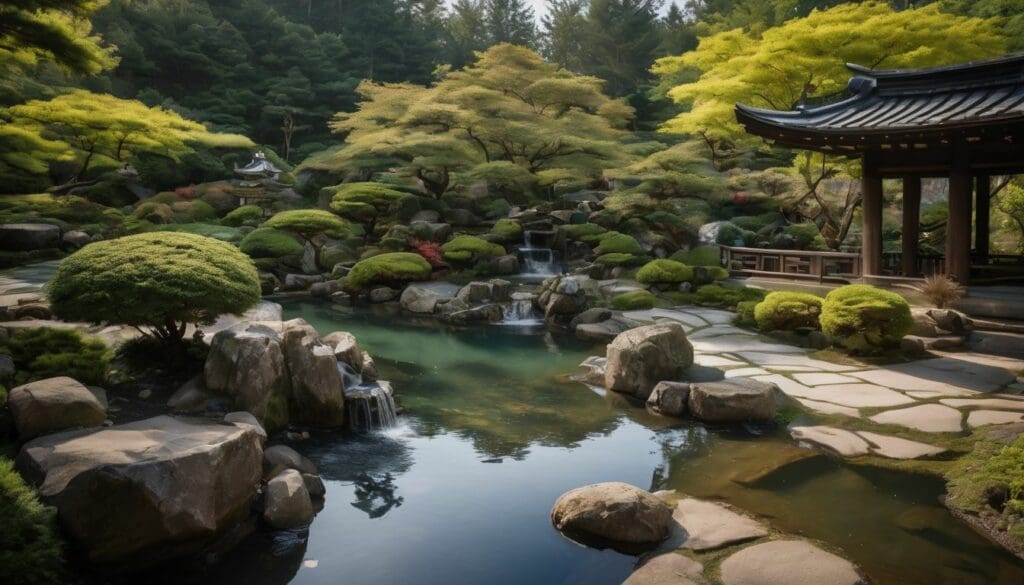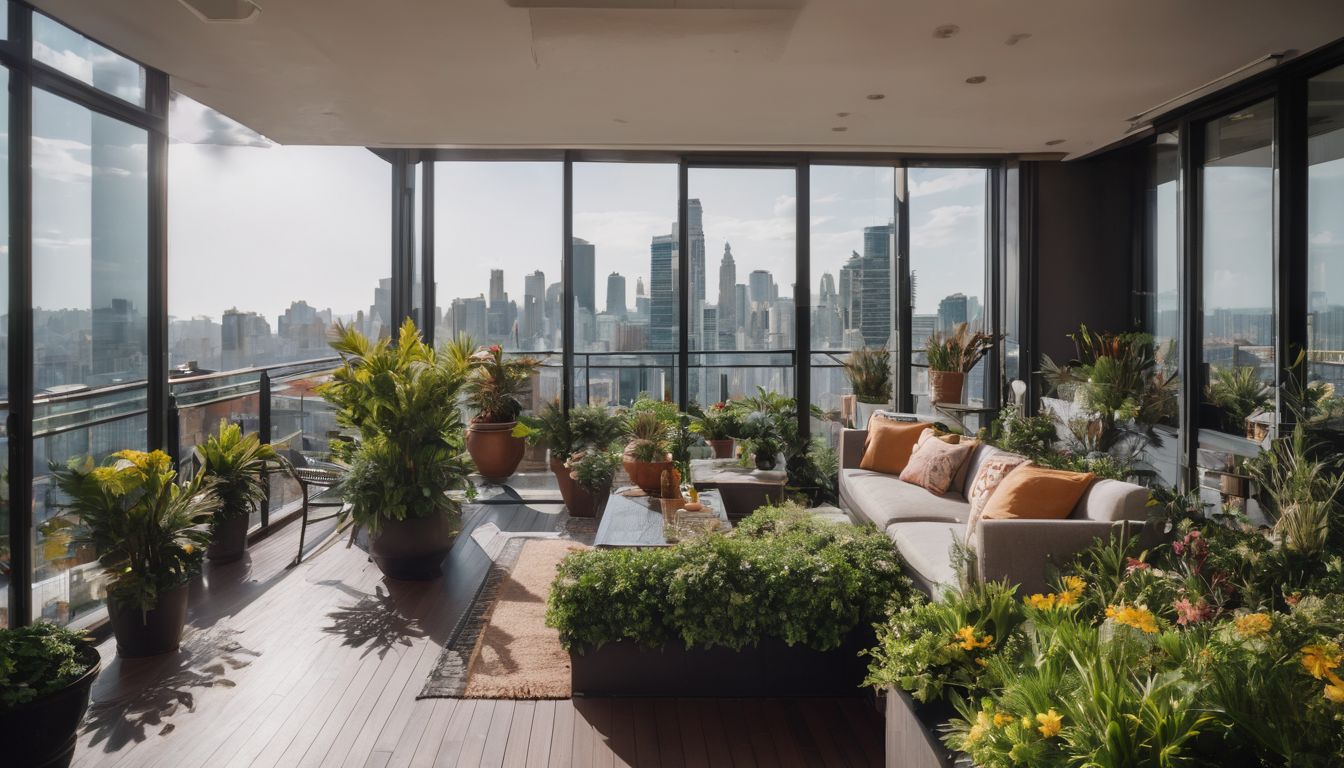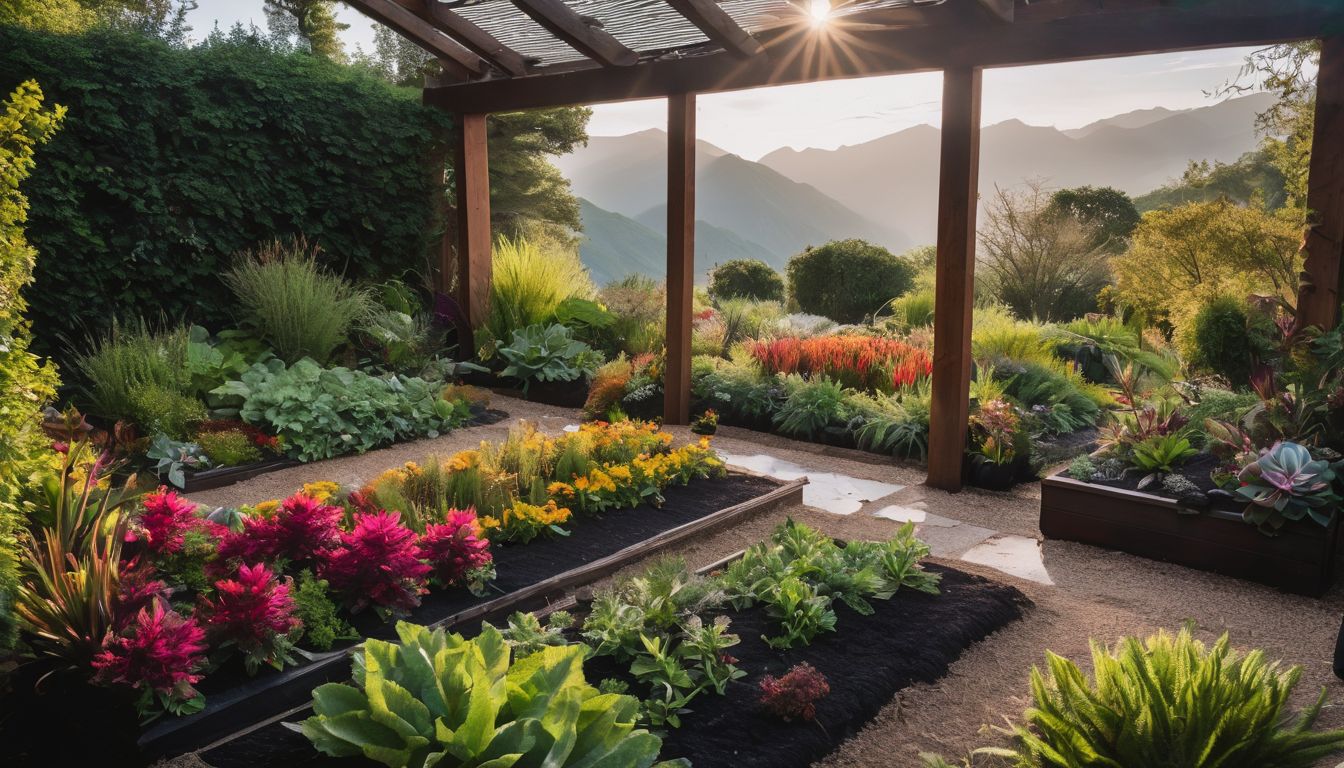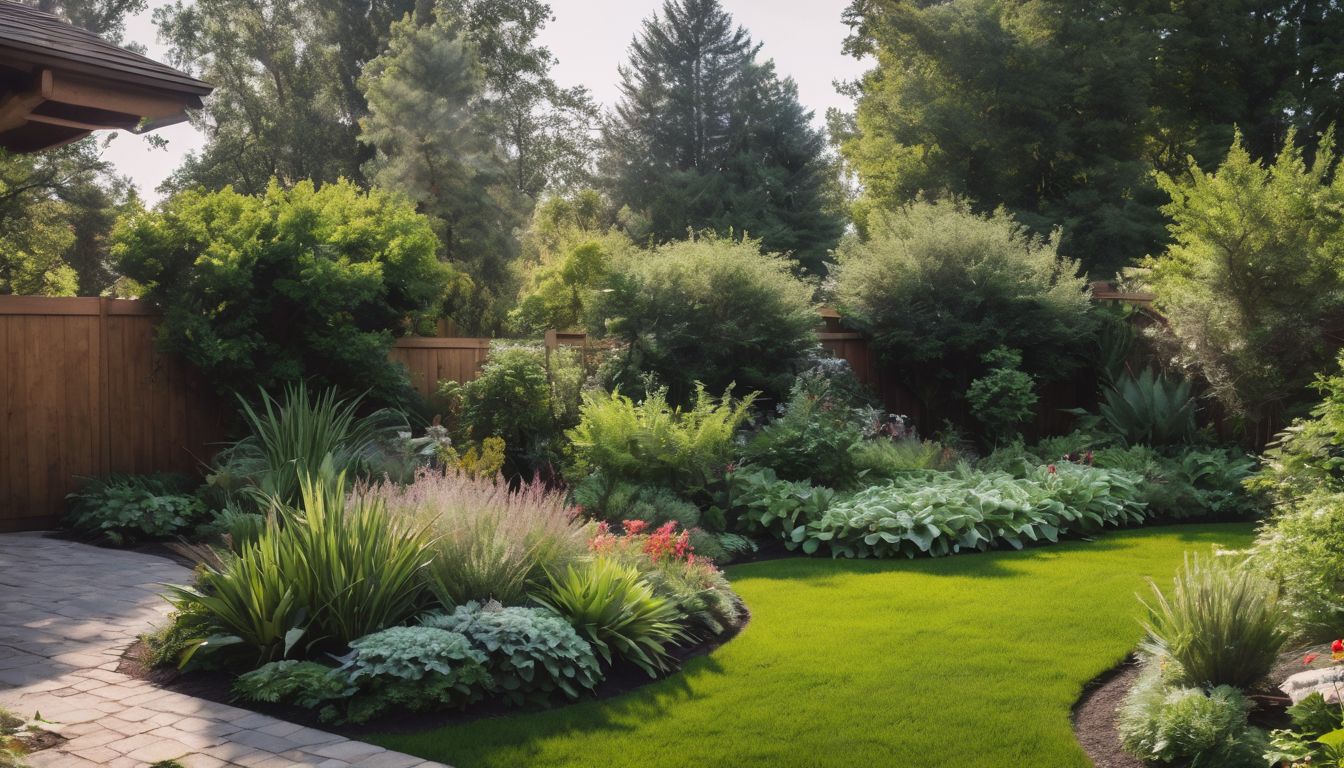Top Garden Trends for 2023
In 2023, garden enthusiasts are embracing the trend of growing their own bouquets and creating cottage gardens. They are also turning to Mediterranean-style gardens and swapping traditional lawns for wildflower meadows.
Additionally, they’re expanding their houseplant collections with rare varieties and learning from experts through online webinars.
Growing Your Own Bouquets
Growing your own bouquets adds a personal touch to your garden design, while also promoting sustainability. Choose flowers that thrive in your local climate and you’ll save water and reduce the need for heavy maintenance.
Plant varieties like lavender, roses, and sunflowers that not only look stunning but attract beneficial pollinators to your garden too.
Harvesting these blooms gives you fresh, organic decor for your home and can be done without harming the environment. Use companion planting techniques to boost growth naturally instead of relying on chemical fertilisers.
This trend combines beauty with eco-consciousness perfectly, letting gardeners create eye-catching arrangements that are kinder to our planet.
Creating Cottage Gardens
Transitioning from growing your own bouquets, creating cottage gardens adds a touch of nostalgia and whimsy to any outdoor space. These gardens are characterised by their informal layouts, overflowing with an abundance of colourful flowers and aromatic herbs.
The aim is to create a relaxed atmosphere that feels like an escape from the hustle and bustle of everyday life.
To achieve this look, mix annuals, perennials, and biennials together in charming disarray. Try incorporating traditional cottage garden plants such as roses, lavender, peonies, foxgloves, and delphiniums.
Designing Mediterranean-Style Gardens
To design Mediterranean-style gardens, choose plants like lavender, rosemary, and olive trees. Utilise natural materials such as terracotta pots and stone pathways. Incorporate colourful tiles for a pop of vibrant hues.
Use drought-tolerant plants to thrive in the warm climate and make sure to include seating areas for relaxation.
Create an inviting space with winding paths and aromatic herbs. Include water features like fountains or small ponds for a serene atmosphere. Embrace the simplicity of this style by keeping the design uncluttered and using earthy tones throughout the garden.
Swapping Lawns for Meadows
Swap traditional lawns for meadows to create a more eco-friendly and low-maintenance garden. Meadows are not only visually appealing but also support local wildlife, including bees and butterflies.
Drought-tolerant plants can be incorporated into the meadow design to conserve water while providing year-round interest with diverse textures and colors. By embracing this trend, you can contribute to climate-conscious gardening practices, promoting biodiversity in your outdoor space.
Incorporate a variety of native grasses and wildflowers in your meadow design to attract beneficial insects and provide food sources for local wildlife, creating a thriving ecosystem right in your own backyard.
Learning From Experts Through Online Webinars
Brush up on your gardening skills by learning from the experts through online webinars. Stay updated with the latest trends, techniques, and sustainable practices in garden design.
Gain insightful knowledge on front yard landscaping, garden decor, climate-conscious gardening, and Mediterranean-style gardens. These informative webinars will help you incorporate drought-tolerant plants, vertical gardening, and naturalistic planting into your own environmentally healthy garden designs.
Discover innovative ways to enhance your outdoor spaces while supporting conservation efforts and promoting a greener environment. Embrace the opportunity to expand your expertise and join like-minded individuals in creating beautiful and sustainable gardens for a brighter future.
Expanding Houseplant Collections with Rare & Unusual Varieties
Expand your houseplant collection with unique and rare varieties to add intrigue and vibrancy to your indoor space. Seek out unusual plants such as the sensitive plant (Mimosa pudica) or the prayer plant (Maranta leuconeura) to bring a touch of curiosity into your home.
Embrace the challenge of nurturing plants that are not commonly found, supporting biodiversity within your living environment. Increase your botanical knowledge while making a positive contribution to conservation efforts by growing these distinctive houseplants.
Ready for more excitement in outdoor spaces? Let’s explore “Adding Texture with Foliage Plants” and discover how foliage can transform garden designs.
Adding Texture with Foliage Plants
Foliage plants add depth and interest to any garden. They come in various shapes, sizes, and colours, providing a rich tapestry of textures. From the bold leaves of hostas to the delicate fronds of ferns, foliage plants bring visual appeal while requiring less maintenance than many flowering varieties.
By incorporating a diverse selection of foliage plants, you can create a dynamic and vibrant landscape that enhances the overall aesthetic of your garden.
Incorporating foliage plants not only adds visual texture but also contributes to the ecological balance by providing habitats for beneficial insects and wildlife. This creates a sustainable environment that supports conservation efforts and promotes biodiversity within your outdoor space.
Going Vertical
Vertical gardening is a popular trend for 2023, especially among environmentally conscious individuals. It involves growing plants upwards on walls, fences, or trellises to save space and add visual interest.
By using this technique, gardeners can maximise their available space and create lush greenery in small areas while promoting the conservation of land and natural resources. Using drought-tolerant plants in vertical gardens also supports climate-conscious gardening by reducing water usage and creating sustainable landscapes that thrive with minimal maintenance.
To incorporate this trend into your own garden design, consider installing living walls, hanging planters, or vertical plant structures to elevate your outdoor space while contributing to environmental stewardship.
Making Outdoor Spaces Cheery & Bright
Creating a cheerful and bright outdoor space is key to enjoying your garden. Incorporating colourful, blooming flowers such as daisies, marigolds, and petunias can instantly elevate the atmosphere.
Utilising solar-powered fairy lights or lanterns can illuminate the area in an eco-friendly manner while adding a touch of enchantment to your outdoor space. Integrating vibrant cushions, rugs, and throws into your patio furniture setup will contribute to a lively and inviting ambience.
Additionally, opting for brightly painted planters or garden ornaments can infuse playfulness and character into the environment.
Incorporating bright colours through flowers, lighting, and accessories creates an inviting and uplifting atmosphere in your outdoor space. Solar-powered lights offer an eco-friendly way to illuminate the area while adding charm.
Using Natural Materials
Garden design trends for 2023 emphasise using natural materials. Incorporating sustainable and eco-friendly items such as reclaimed wood, natural stone, and organic fabrics is gaining popularity.
These materials not only add a rustic charm but also contribute to an environmentally healthy garden that supports conservation efforts.
Incorporating natural materials in garden design promotes a harmonious relationship with the environment. Utilising locally sourced stones and untreated woods not only adds character to outdoor spaces but also reduces the carbon footprint associated with transportation.
Garden Trends for 2024
Enhancing Your Garden with Edimentals, exploring naturalistic planting & the new perennial movement, preserving every drop with eco-friendly rain gardens and learning to love bugs.
To discover more exciting garden trends for 2024, keep reading!
Enhancing Your Garden with Edimentals
Enhance your garden with edimentals, a term combining edible and ornamental. Edimental plants serve a dual purpose, offering both aesthetic value and culinary use. Integrate these plants into your garden landscape to create a beautiful and functional outdoor space while promoting sustainable living.
Grow edible flowers like nasturtiums or pansies for adding color to salads or garnishing dishes. Herbs such as lavender, rosemary, and thyme provide fragrance and flavor along with attracting pollinators to support biodiversity in the garden.
Embrace the concept of edible landscaping by incorporating fruits like strawberries or blueberries into your garden design, creating an aesthetically pleasing environment that also provides fresh produce for your table.
Exploring Naturalistic Planting & the New Perennial Movement
For environmentally conscious gardeners, exploring naturalistic planting and the new perennial movement can offer a sustainable and low-maintenance approach to gardening. Naturalistic planting focuses on creating landscapes that mimic the patterns found in nature, using native plants that require minimal care and resources.
This trend not only supports biodiversity but also helps conserve water, reduce chemical usage, and create habitats for local wildlife. Embracing this movement can bring forth beautiful, ecologically sound gardens that thrive with minimal intervention.
The new perennial movement promotes the use of long-lived herbaceous perennials in landscape design. By incorporating these plants in garden designs, individuals can enjoy a diverse array of blooms while reducing the need for frequent replanting.
This approach supports sustainability by promoting plant diversity, fostering ecological balance, and reducing maintenance needs through resilient plant selections that are well-suited to their environment.
Preserving Every Drop with Eco-Friendly Rain Gardens
Eco-friendly rain gardens help preserve water by capturing and filtering runoff from roofs, driveways, and other hard surfaces. These gardens are designed to absorb rainwater, reducing the risk of flooding and erosion.
By using native plants with deep roots, they prevent pollutants from entering groundwater supplies and provide habitats for birds, bees, and other wildlife. Rain gardens also contribute to climate-conscious gardening practices by reducing the demand for irrigation systems.
Implementing eco-friendly rain gardens in your backyard landscaping not only conserves water but also helps create a sustainable environment that supports biodiversity while adding beauty to outdoor spaces.
Learning to Love Bugs
Incorporating bugs into your garden can benefit the ecosystem by attracting pollinators, pest predators, and decomposers. Embracing insects in your garden helps create a balanced and healthy environment for plants to thrive naturally.
Introducing native plants and providing habitats such as insect hotels or birdbaths will encourage a wide variety of bugs to inhabit your space, contributing to a thriving and sustainable garden.
Moving on to the next trend, let’s explore how Edimentals are enhancing gardens in 2024.
Top Garden Trends for 2023
Garden of Eden, Architectural Simplicity, Upscale Relaxation, New Victorian, Scandinavian Minimalism, Waterwise Plants, and Japanese-Inspired Gardens are the top garden trends for 2023.
Each trend offers a unique and stylish approach to garden design that reflects the latest in aesthetic preferences and sustainability practices.
Garden of Eden
The “Garden of Eden” trend brings a touch of paradise to your outdoor space, focusing on lush, abundant planting and creating a harmonious natural environment. Embracing this trend means using an eclectic mix of plants with different shapes, textures, and colors that thrive in your local climate.
By incorporating native species and wildlife-friendly features such as bird feeders and insect hotels, you can create a biodiverse haven that supports local ecosystems while offering a serene retreat for yourself.
Under the “Garden of Eden” theme, consider incorporating meandering pathways lined with vibrant flowers and aromatic herbs to encourage exploration and relaxation. Adding water features like ponds or small streams can enhance the sense of tranquility in your garden oasis.
Architectural Simplicity
Transitioning from the lush and abundant design ethos of “Garden of Eden”, 2023 is also embracing the concept of architectural simplicity. This trend focuses on clean lines, open spaces, and minimalist features that blend seamlessly with nature.
Embracing architectural simplicity in garden design allows for a harmonious integration of both natural and man-made elements.
Architectural simplicity encourages the use of geometric shapes, sleek materials like concrete and metal, as well as uncluttered layouts to create a modern yet serene outdoor space.
Upscale Relaxation
Create a luxurious garden retreat with upscale relaxation features. Install a sleek water feature like a fountain or small pond to add an element of tranquillity. Incorporate comfortable seating areas using eco-friendly materials such as reclaimed wood or sustainable rattan furniture, which blend seamlessly into the landscape while providing a cosy spot for unwinding.
Integrate aromatic plants like lavender, jasmine, and rosemary to infuse the air with soothing scents, enhancing the overall sense of calm and relaxation in your garden.
For added ambience, incorporate soft outdoor lighting to extend the usability of your garden into the evening hours. Consider solar-powered lights or LED fixtures that consume minimal energy while still creating an inviting atmosphere.
New Victorian
Transitioning from the concept of “Upscale Relaxation,” the New Victorian garden trend combines traditional elements with a contemporary twist. This design approach takes inspiration from the Victorian era, integrating classic floral displays, intricate patterns, and elegant structures with a modern, eco-friendly ethos.
Embracing biodiversity and sustainability, this trend incorporates native plants, organic materials such as reclaimed wood and natural stone, and wildlife-friendly features to create a lush yet environmentally conscious outdoor space.
By blending historic charm with conservation principles in their garden designs, environmentally conscious individuals can contribute to preserving nature while enjoying a timeless aesthetic.
Scandinavian Minimalism
Scandinavian minimalism emphasises clean, simple lines and functional design. It embraces a pared-back aesthetic that focuses on natural materials such as wood, stone, and leather.
By incorporating eco-friendly rain gardens and water-wise plants, you can achieve the serene and uncluttered look of Scandinavian minimalism while supporting conservation efforts.
Incorporating drought-tolerant plants into your garden not only aligns with the principles of Scandinavian minimalism but also promotes environmental sustainability. Additionally, using natural materials like wood for raised planters or stone for garden pathways contributes to an organic outdoor space while minimising environmental impact.
Waterwise Plants
Transitioning from the clean lines and simplicity of Scandinavian Minimalism to the concept of Waterwise Plants, gardeners are increasingly turning to drought-tolerant options. With a focus on conserving water and supporting a sustainable environment, these plants require minimal watering once established.
Many beautiful varieties fall into this category, including lavender, yucca, agave, and ornamental grasses. By incorporating such species into your garden design, it’s possible to create an eco-friendly oasis that simultaneously reduces water consumption and supports local wildlife.
Selecting Waterwise Plants not only benefits the environment but also provides an opportunity for creativity in landscaping. Embracing these plant choices allows for the creation of stunning visual displays while contributing positively to conservation efforts.
Japanese-Inspired Gardens
Transitioning from the concept of waterwise plants, consider the allure of Japanese-inspired gardens. These serene and tranquil spaces encourage a deep connection with nature, promoting peace and tranquillity.
Incorporating elements such as Zen rock gardens, bamboo fences, and carefully pruned trees creates a meditative ambiance that suits an environmentally healthy lifestyle. By embracing these design principles, you can build a sustainable outdoor sanctuary that fosters mindfulness while respecting the environment.
Immerse yourself in simplicity and harmony by exploring Japanese-inspired garden designs. Utilise natural materials and minimalist aesthetics to create an eco-friendly space that promotes calmness and balance within your surroundings.
10 Big Garden Design Trends for 2023
Embrace environmentally healthy gardens with drought-tolerant plants, as well as the return of the cottage garden and the rise of maximalism and vertical gardening. Climate-conscious gardening is at the forefront of these top trends for 2023.
Environmentally Healthy Gardens
Environmentally healthy gardens promote biodiversity, conserve water, and reduce the need for chemical pesticides. Incorporating native plants and drought-tolerant varieties supports local ecosystems and minimises water consumption.
By embracing climate-conscious gardening practices, such as composting and mulching, you can create a sustainable garden that benefits the environment while providing a beautiful outdoor space.
Using natural materials in landscaping and opting for eco-friendly hardscaping options helps to reduce the carbon footprint of your garden.
Drought-tolerant plants play a crucial role in environmentally healthy gardens by reducing the demand for irrigation and fostering resilience in changing climates. These low-maintenance varieties not only conserve resources but also add visual interest with unique textures and foliage patterns.
Drought-Tolerant Plants
Transitioning from environmentally healthy gardens, another key trend in garden design for 2023 is the focus on drought-tolerant plants. These resilient species are essential for water conservation and eco-friendly landscaping.
Drought-tolerant plants, also known as xerophytes, thrive in arid conditions and require minimal watering, making them an ideal choice for sustainable gardening.
Gardeners are increasingly opting for drought-tolerant plants not only for their environmental benefits but also for their low-maintenance appeal. With a wide range of stunning succulents, ornamental grasses, and flowering perennials available, creating a vibrant and water-efficient landscape has never been easier.
Return of the Cottage Garden
Cottage gardens are making a comeback, embracing biodiversity and sustainability. These gardens combine edibles with ornamental plants, encouraging beneficial insects and pollinators.
Drought-tolerant plants are often featured in these charming spaces, contributing to climate-conscious gardening by reducing water usage. By incorporating natural materials and avoiding chemical pesticides, cottage gardens support the environment while offering a picturesque retreat for homeowners.
Moving on to “Maximalism” – let’s explore how this trend is transforming garden design for 2023.
Maximalism
Continuing the trend of embracing lush greenery and abundant blooms, maximalism in garden design focuses on creating rich, vibrant landscapes that overflow with a diverse range of plants and features.
Embracing biodiversity and complexity, maximalist gardens are bursting with layers of color, texture, and form. This trend allows for an eclectic mix of plant varieties to coexist harmoniously while providing ample food sources for local wildlife.
By incorporating a wide array of species into the garden ecosystem, you can create a dynamic and thriving habitat that supports conservation efforts while delighting the senses with its exuberant visual appeal.
To achieve maximalism in your garden design, consider integrating an assortment of flowering perennials, ornamental grasses, foliage plants, shrubs, climbers, and trees to provide depth and variety.
Vertical Gardening
Maximalism adds energy and excitement to garden designs, but for those looking to make the most of limited space, vertical gardening is the way forward. Utilising walls and fences for planters or trellises opens up endless possibilities for growing flowers, herbs, and even vegetables in a compact area.
By going vertical, gardeners can create lush green backdrops or vibrant pops of colour without taking up valuable ground space. This innovative technique not only maximises planting opportunities but also adds a dynamic visual element to any outdoor area.
To support conservation and environmental efforts while still enjoying a beautiful garden, incorporating vertical gardening into your design allows you to embrace sustainable practices by maximising space utilisation with drought-tolerant plants.
Climate-Conscious Gardening
Transitioning from making the most of vertical space in gardening to a more environmentally conscious approach, climate-conscious gardening is gaining momentum. This trend involves choosing plants that are well-suited to the local climate and require minimal water, thereby reducing the ecological impact of your garden.
Drought-tolerant plants are a key feature of this trend, as they can thrive with little water, helping to conserve this precious resource. Adopting sustainable gardening practices such as composting, mulching, and using organic fertilisers further aligns with climate-conscious gardening principles.
By prioritising eco-friendly techniques and plant choices, you can create a beautiful garden that benefits both your surroundings and the wider environment.
Conclusion
Embrace the latest trends in garden design to create your own eco-friendly oasis. Incorporate climate-conscious gardening practices and drought-tolerant plants to contribute to environmental conservation.
Explore Mediterranean-style gardens, vertical gardening, and the return of the cottage garden for a sustainable and beautiful outdoor space.
FAQs
1. What are some of the latest trends in garden design?
The newest trends include climate-conscious gardening practices, using drought-tolerant plants, and creating Mediterranean-style gardens that conserve water and thrive in warm temperatures.
2. How can I make my garden more climate-conscious?
You can choose plants that require less water and care by considering drought-tolerant varieties which adapt better to changing weather patterns.
3. Can you explain what a Mediterranean-style garden is?
Mediterranean-style gardens are designed to mirror the coastal regions’ landscapes, featuring hardy shrubs and perennials that cope well with dry conditions.
4. Why should I use drought-tolerant plants in my garden?
Opting for drought-tolerant plants helps your garden stay resilient during dry spells while reducing the need for frequent watering, making your outdoor space eco-friendlier.





